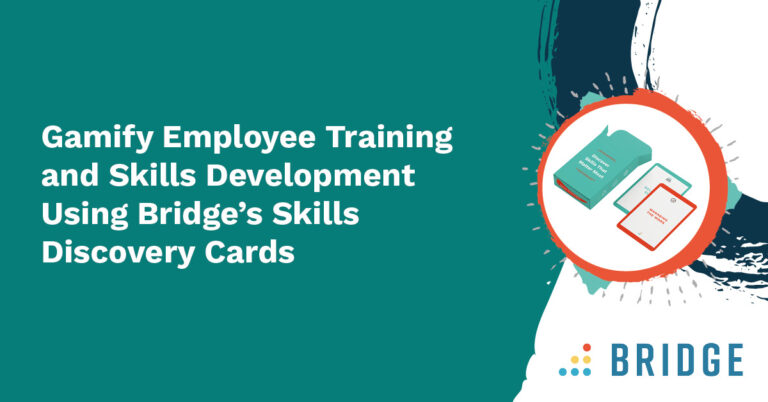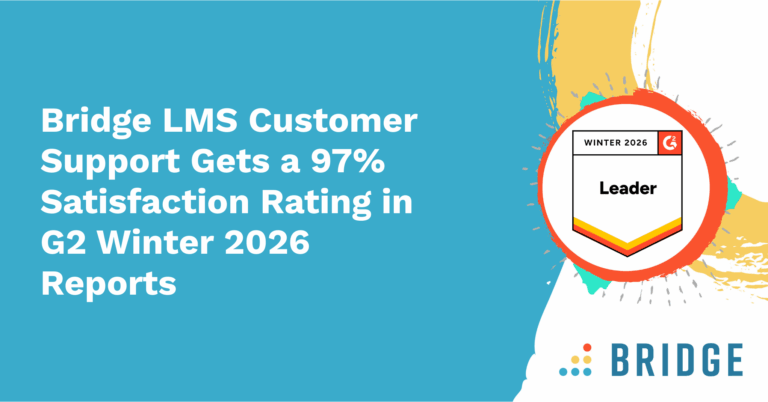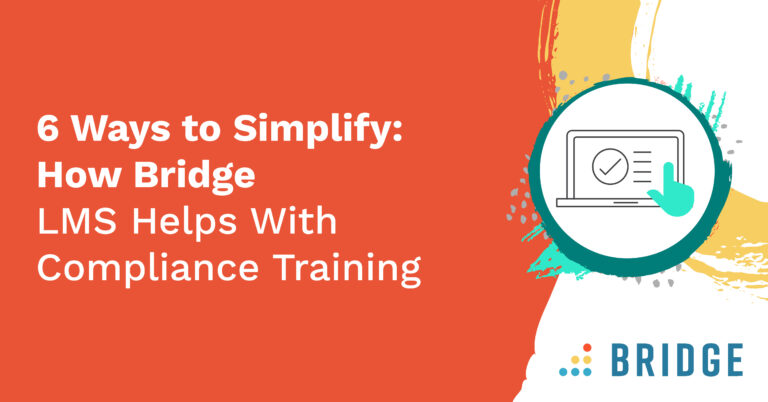If you’re anything like the respondents to the Bridge-sponsored “Future of Upskilling and Employee Learning 2024” report, there’s a good chance that you consider employee upskilling to be a top-three organizational priority. That said, the report also found that less than half of all respondents actually assess employee skills gaps—and only 39% educate employees to self-evaluate their skills gaps.
In short, you might recognize the value of upskilling without being sure of what skills your people need!
Here’s the good news: your initial skills gaps assessments don’t have to be a complex process. In fact, with a little help from Bridge, you’ll find they can be fun exercises that allow your people managers to take the lead—and form stronger relationships with their reports in the process.
Read on to discover how Bridge’s skills discovery card game can walk your managers through the initial process of assessing employee skills needs (and how Bridge’s AI-powered upskilling capabilities can take care of the rest).
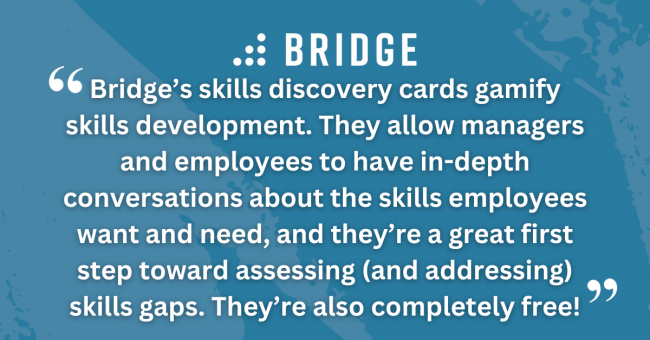
What Is Skills Development?
Skills development refers to the process of gaining new competencies. What does that look like? Well, it can look something like Bridge’s development planning feature: an environment where employees select skills they want to develop and map out the learning and goals that will help them gain those skills. That’s the core of effective skills development: a multi-faceted selection of activities built around acquiring the skills your people need to thrive and grow.
But what if your people aren’t sure what skills they need to achieve that growth? And what if your managers aren’t sure how best to advise them?
That’s where Bridge’s skills discovery game comes into play.
READ MORE ABOUT SKILLS | ‘How to Develop a Skills Management Plan (And Why Managers Are Crucial to Success)’
How to Use Bridge Skills Discovery Cards
Bridge’s skills discovery cards gamify skills development. They allow managers and employees to have in-depth conversations about the skills employees want and need, and they’re a great first step toward assessing (and addressing) skills gaps.
They’re also completely free!
Here’s how they work.
RELATED READING | ‘4 HR Strategies for Manager Enablement’
Step 1) Make Initial Skills Selections
Kickstarting the process is as simple as splitting the cards into six skills categories (which we’ve helpfully organized by color!).
For each category—including productivity, relationships, and personal growth—your managers and their reports each select the most important skills for ongoing career growth (up to a maximum of two).
Once your managers and their reports are left with a pile of selected skills, it’s time to move on to the next phase.
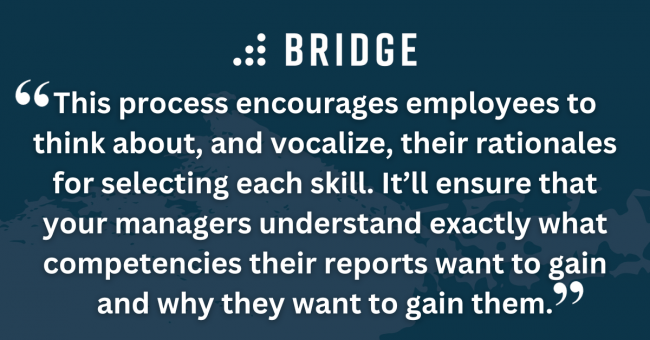
Step 2) Choose the Top 5 Skills to Focus On
This exercise is all about narrowing down your options until you’ve got a couple of solid, well-reasoned options to work with. It’s worth emphasizing to your managers that step two is a crucial part of the whittling-down process.
So, how can your people leaders get it done? It all starts with mixing up the skills pile they’ve selected with their reports. After a quick shuffle, they’ll need to pick out five cards and lay them out.
After that, it’s just a question of drawing out the remaining cards from the deck, one by one, and asking the employee whether they want to discard it or swap it with one of the existing five. This is a process that encourages employees to think about, and vocalize, their rationales for selecting each skill. It’ll ensure that your managers understand exactly what competencies their reports want to gain and why they want to gain them.
Step 3) Prioritize Skills to Develop
Having five well-considered skills to focus on is a great position, but you don’t want your managers to overwhelm their reports by setting them too many skills development objectives. Instead, encourage your managers to whittle this core collection of skills down to two options for their reports to work on over the next year or so. Here’s what your managers will need to do.
Take two pens, placing one above the five focus skills and one below. The top pen represents higher-priority skills, while the lower one represents lower-priority skills. With this handy piece of visualization in place, your managers can ask employees to move the skills cards up and down to quickly establish which skills matter most.
Through this process, the employee selects one skill—and your managers can supplement it with a skill of their choosing. The result? A realistic number of high-priority skills to acquire and improve—all while getting your managers clued up on what makes their reports tick.
Not bad for a half-hour card game!
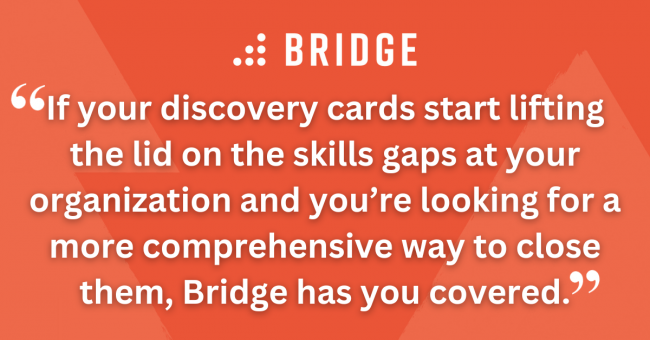
Supplement Your Leadership’s Skills Development Findings With AI Upskilling Technology
Bridge’s skills discovery card game is a great way to help your managers engage with the skills development process and forge stronger relationships with their reports. But why stop there?
After all, while it’s essential to support individual employee aspirations and take full advantage of managerial know-how, these aren’t the only ways to identify skills needs. That’s why Bridge comes equipped with upskilling capabilities that use AI to recommend up-to-date skills based on your workers’ job titles.
Better still, Bridge can then suggest training resources that allow employees to develop those skills—all while automatically tagging your learning courses with relevant skills so you don’t need to lift a finger. Combined with its community capabilities, in which like-minded employees with shared skills needs can come together to learn, grow, and support one another, Bridge has everything you need to keep your people in a permanent state of meaningful development.
So, if your discovery cards start lifting the lid on the skills gaps at your organization and you’re looking for a more comprehensive way to close them, Bridge has you covered.
MORE FROM THE BLOG | ‘Skills Management Planning: A 5-Step Checklist to Grow Cutting-Edge Competencies’
Get Your Skills Discovery Cards Today—Then Let Bridge Take Care of Your Skills Gaps
Bridge’s skills discovery cards are completely free. Find out what skills your people and their managers want to develop, then supplement the results with the help of Bridge’s AI-powered upskilling capabilities. Discover skills requirements that draw from your workers’ job titles, your industry, and the latest market developments, then watch as those requirements are met with the help of fully automated learning recommendations.
